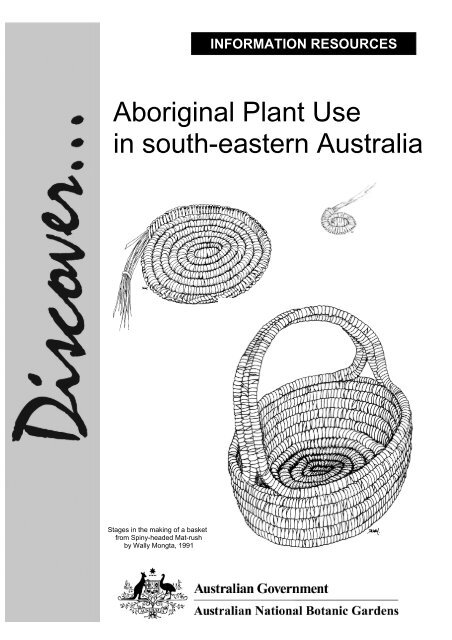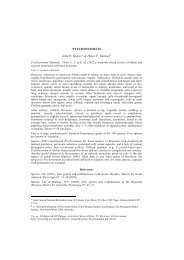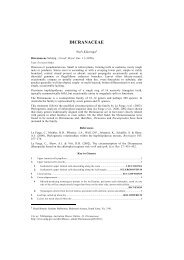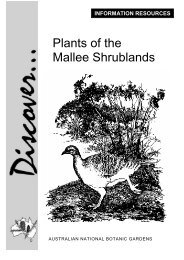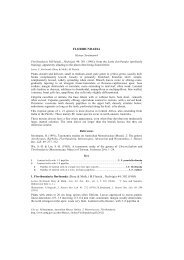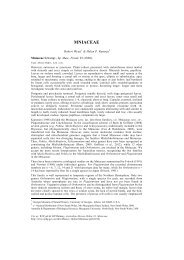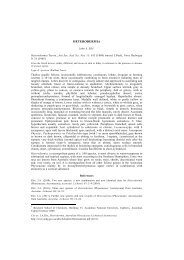Aboriginal plant use in south eastern Australia - Australian National ...
Aboriginal plant use in south eastern Australia - Australian National ...
Aboriginal plant use in south eastern Australia - Australian National ...
You also want an ePaper? Increase the reach of your titles
YUMPU automatically turns print PDFs into web optimized ePapers that Google loves.
<strong>Aborig<strong>in</strong>al</strong> Plant Use<br />
<strong>in</strong> <strong>south</strong>-<strong>eastern</strong> <strong>Australia</strong><br />
Stages <strong>in</strong> the mak<strong>in</strong>g of a basket<br />
from Sp<strong>in</strong>y-headed Mat-rush<br />
by Wally Mongta, 1991<br />
INFORMATION RESOURCES
Text by Daphne Nash<br />
Artwork<br />
Donna Wahl Cover (Stages <strong>in</strong> the mak<strong>in</strong>g of a basket from Sp<strong>in</strong>y-headed Mat-rush<br />
by Wally Mongta, 1991)<br />
P2 (banksia, needle), p8 (spear thrower), p14 (stages <strong>in</strong> basketmak<strong>in</strong>g).<br />
Christ<strong>in</strong>e Payne p2 (<strong>in</strong>digo), p3, p4 (native cherry, rafts), p5, p6, p7, p8 (all<br />
except spear thrower), p9 (lily, kurrajong, net), p10 (nardoo),<br />
p11, p12, p13 (mat-rush, eel traps), p15, p16.<br />
Bev Bruen p13 (tree-fern).<br />
Cameron McDonald p4 (common reed, necklace) p9 (bowl, gr<strong>in</strong>d<strong>in</strong>g stone).<br />
Maryanne Traill p9 (kangaroo grass).<br />
Franki Sparke p10 (mistletoe)<br />
Leife Shallcross p14 (eel trap, f<strong>in</strong>ished basket)<br />
This material can only be copied for non-commercial education purposes.<br />
Revised February 2004<br />
Produced by Education Services<br />
<strong>Australia</strong>n <strong>National</strong> Botanic Gardens.<br />
Clunies Ross Street, Acton ACT 2601<br />
The <strong>Australia</strong>n <strong>National</strong> Botanic Gardens –<br />
Mission: grow, study and promote <strong>Australia</strong>n <strong>plant</strong>s.<br />
2. AUSTRALIAN NATIONAL BOTANIC GARDENS
<strong>Aborig<strong>in</strong>al</strong> Plant Use <strong>in</strong> South-<strong>eastern</strong> <strong>Australia</strong><br />
Contents : Page<br />
Plann<strong>in</strong>g the Excursion 1<br />
• About the Questions<br />
• Purpose<br />
• Curriculum l<strong>in</strong>ks<br />
<strong>Aborig<strong>in</strong>al</strong> Plant Use <strong>in</strong> South-east <strong>Australia</strong> 2<br />
• Austral <strong>in</strong>digo 2<br />
• Banksia 2<br />
• Blackwood 3<br />
• Bulrush, Cumbungi 3<br />
• Cherry Ballart, Native Cherry 4<br />
• Common Reed 4<br />
• Flax Lily 5<br />
• Geebung 5<br />
• Gum Trees 7<br />
• Gymea Lily 9<br />
• Kangaroo Grass 9<br />
• Kurrajong 9<br />
• Mistletoe 10<br />
• Nardoo 10<br />
• Native Cypress P<strong>in</strong>e 11<br />
• Native Raspberry 11<br />
• She-Oaks 12<br />
• Soft Tree Fern 13<br />
• Sp<strong>in</strong>y-headed Mat-Rush 13<br />
• Yam Daisy or Murnong 15<br />
Student Worksheet Answers 17<br />
Bibliography 19<br />
Map of the Gardens 20<br />
AUSTRALIAN NATIONAL BOTANIC GARDENS
Plann<strong>in</strong>g the Excursion<br />
We want you to <strong>use</strong> the Information Resource Notes and example Student Worksheets as<br />
resources for plann<strong>in</strong>g your excursion. Select questions that relate to the purpose of the<br />
excursion, cut and paste, modify and add your own activities. There is some repetition of<br />
concepts and students cannot complete all activities with<strong>in</strong> an hour. The concepts can be<br />
adapted to all levels, and the activities tailored to the time available <strong>in</strong> the Gardens.<br />
Let us have a copy of your f<strong>in</strong>ished worksheets so we can share your ideas with others.<br />
<strong>Aborig<strong>in</strong>al</strong> Plant Use <strong>in</strong> <strong>south</strong>-<strong>eastern</strong> <strong>Australia</strong> is a directed walk that leaves the Ma<strong>in</strong><br />
Path near marker 21 (ie 210 metres from the footbridge by the car park) and f<strong>in</strong>ishes back<br />
near the footbridge. See map attached. Interpretive signs occur by selected <strong>plant</strong>s along<br />
the way. This booklet conta<strong>in</strong>s all the <strong>in</strong>formation on the signs along with <strong>in</strong>formation<br />
about other important <strong>plant</strong>s that occur <strong>in</strong> the Gardens.<br />
While students are <strong>in</strong> the Gardens it is more beneficial for them to be observ<strong>in</strong>g,<br />
discover<strong>in</strong>g and develop<strong>in</strong>g attitudes and values rather than read<strong>in</strong>g swags of text and<br />
writ<strong>in</strong>g comprehensive answers to questions. Good pre-visit and post-visit activities are<br />
important. Students can see <strong>Aborig<strong>in</strong>al</strong> artefacts on display <strong>in</strong> the Education Centre and<br />
experience the walk <strong>in</strong> the Gardens. A special artefacts kit, posters and books are<br />
available for loan from the Education Centre.<br />
About the Questions<br />
• The questions are open-ended so that students are encouraged to observe and th<strong>in</strong>k.<br />
• They are <strong>in</strong>tended as m<strong>in</strong>d joggers for teachers to develop their own questions based<br />
on the outcomes they want.<br />
• There are too many questions <strong>in</strong>cluded here for students to successfully answer <strong>in</strong><br />
one visit. Post-visit activities could take <strong>in</strong> more of the questions.<br />
• They are written for adult readers and may need to be modified for students.<br />
Purpose<br />
The <strong>Aborig<strong>in</strong>al</strong> Plant Use activities focus on the <strong>Australia</strong>n bush provid<strong>in</strong>g all the basic<br />
needs for survival of <strong>Aborig<strong>in</strong>al</strong> people for over 40,000 years, looks at aspects of the<br />
social fabric of <strong>Aborig<strong>in</strong>al</strong> society, and <strong>plant</strong> <strong>use</strong> today. It <strong>in</strong>cludes <strong>use</strong> of <strong>plant</strong>s for food,<br />
medic<strong>in</strong>e, tools, utensils, ceremony, hunt<strong>in</strong>g and everyday life.<br />
Curriculum l<strong>in</strong>ks<br />
The activities <strong>in</strong> this walk allow for l<strong>in</strong>ks across the curriculum, particularly <strong>in</strong> Studies of<br />
Society and Environment, Science, Technology and Health & Physical Education<br />
Suggested levels years 3-12).<br />
(<br />
AUSTRALIAN NATIONAL BOTANIC GARDENS 1.
<strong>Aborig<strong>in</strong>al</strong> <strong>plant</strong> <strong>use</strong> <strong>in</strong> <strong>south</strong>-<strong>eastern</strong> <strong>Australia</strong><br />
Text by Daphne Nash<br />
This section conta<strong>in</strong>s detailed notes and a bibliography on <strong>plant</strong>s <strong>use</strong>d by <strong>Aborig<strong>in</strong>al</strong><br />
peoples of <strong>south</strong>-<strong>eastern</strong> <strong>Australia</strong>.<br />
There is an <strong>Aborig<strong>in</strong>al</strong> Plant Use Walk marked by <strong>in</strong>terpretive signs at the Gardens. A<br />
leaflet is available for this walk which covers a wide range of <strong>plant</strong> species from all parts<br />
of <strong>Australia</strong>.<br />
The follow<strong>in</strong>g <strong>plant</strong>s are listed <strong>in</strong> alphabetic order of common name.<br />
Austral Indigo<br />
Indigofera australis<br />
Habitat: Open forests<br />
Season: Spr<strong>in</strong>g flower<strong>in</strong>g<br />
Crushed leaves were added to water to kill or stun fish like eels<br />
and Murray Cod.<br />
Banksia<br />
Banksia (various species)<br />
Habitat: Heaths, scrub and dry, open forests<br />
Season: Various flower<strong>in</strong>g times<br />
Q: How do you get to taste the sweet nectar?<br />
A: Soak the flowers <strong>in</strong> water <strong>in</strong> a bark or wooden bowl.<br />
Q: What could you do with a dry cone?<br />
A: Banksia marg<strong>in</strong>ata (Silver Banksia) reta<strong>in</strong>s the dry<br />
flowers on the cones which some Victorian<br />
<strong>Aborig<strong>in</strong>al</strong> groups <strong>use</strong>d to stra<strong>in</strong> their dr<strong>in</strong>k<strong>in</strong>g<br />
water. Other groups <strong>use</strong>d the cones as firebrands.<br />
Tool (needle) made from banksia wood and <strong>use</strong>d <strong>in</strong> the weav<strong>in</strong>g of baskets and<br />
mats. Made by Wally Mongta 1991.<br />
2. AUSTRALIAN NATIONAL BOTANIC GARDENS<br />
Austral Indigo<br />
leaves are a grey green colour.<br />
Dried flower of Silver<br />
Banksia.
Leaves, flowers and seed pod of Blackwood<br />
Bulrush, Cumbungi<br />
Typha species<br />
Blackwood<br />
Acacia melanoxylon<br />
Habitat: High ra<strong>in</strong>fall forests<br />
Season: Spr<strong>in</strong>g – Summer flower<strong>in</strong>g<br />
The f<strong>in</strong>e hard wood of this wattle made<br />
strong spear-throwers, boomerangs, clubs<br />
and shields <strong>in</strong> parts of Victoria.<br />
People soaked the bark <strong>in</strong> water to bathe<br />
pa<strong>in</strong>ful jo<strong>in</strong>ts. The <strong>in</strong>ner bark was <strong>use</strong>d to<br />
make str<strong>in</strong>g.<br />
Return<strong>in</strong>g boomerang made by Laddie Timbery of Huskisson, NSW <strong>in</strong> 1990.<br />
The timber <strong>use</strong>d is Blackwood.<br />
This aquatic <strong>plant</strong> grows all over <strong>Australia</strong>. The<br />
underground stems (rhizomes) are rich <strong>in</strong> starch and can<br />
be cooked by steam<strong>in</strong>g <strong>in</strong> an earth oven. After steam<strong>in</strong>g,<br />
the rhizomes can be chewed to remove the starch and the<br />
rema<strong>in</strong><strong>in</strong>g fibre <strong>use</strong>d to make str<strong>in</strong>g.<br />
The young shoots were eaten raw as a salad. This<br />
<strong>plant</strong> was the most important food for people liv<strong>in</strong>g<br />
along the Murray Darl<strong>in</strong>g River systems.<br />
Technique <strong>use</strong>d for nets made<br />
from str<strong>in</strong>g of Bulrush fibres.<br />
Bulrush<br />
AUSTRALIAN NATIONAL BOTANIC GARDENS 3.
Cherry Ballart, Native Cherry<br />
Exocarpus cupressiformis<br />
Habitat: Forests<br />
Season: Spr<strong>in</strong>g-Autumn flower<strong>in</strong>g<br />
It might look like a small cypress tree, but it has small<br />
amounts of sweet, juicy fruits which would have provided a<br />
spr<strong>in</strong>gtime snack. And that’s not all – the sap was applied as<br />
a cure for snake-bite.<br />
In Gippsland, it provided wood for spear-throwers.<br />
Common Reed<br />
Common Reed<br />
Phragmites australis<br />
Native Cherry<br />
Habitat: Edges of creeks and rivers, especially near coast<br />
Season: Summer<br />
Tasmanian people ate the shoots of the underground stems or<br />
rhizomes. People from the lower Murray River collected<br />
mussels on <strong>in</strong>land lakes us<strong>in</strong>g large, rectangular rafts made<br />
from the long stems layered and bound.<br />
Women made bags and baskets from the leaves and Murray<br />
River people made long, light spears from the tall stems. It<br />
was also <strong>use</strong>d to stick through the septum of the nose as an<br />
ornament.<br />
Necklace made from the stem segments<br />
of the Common Reed, (with Quandong seeds) (1992).<br />
4. AUSTRALIAN NATIONAL BOTANIC GARDENS<br />
Rafts made from the long stems of the Common Reed
Geebung<br />
Persoonia l<strong>in</strong>earis<br />
Flax Lily<br />
Dianella (various species)<br />
Habitat: Heath and dry forest<br />
Season: Spr<strong>in</strong>g flower<strong>in</strong>g<br />
Proof from the past: An old burial ground <strong>in</strong><br />
central Victoria revealed a Dianella leaf, split<br />
and twisted <strong>in</strong>to a cord.<br />
In <strong>south</strong>ern South <strong>Australia</strong>, people boiled<br />
the leaves to dr<strong>in</strong>k as a tea.<br />
Flax Lily The roots and blue fruits of some species are<br />
edible.<br />
Habitat: Forests<br />
Season: Summer flower<strong>in</strong>g<br />
Ripe fruits of the Geebung<br />
Scarce but tasty – the fruits of this and other Persoonia spp.<br />
Were a favoured <strong>Aborig<strong>in</strong>al</strong> food.<br />
Str<strong>in</strong>g and fish<strong>in</strong>g l<strong>in</strong>es were soaked <strong>in</strong> Geebung bark<br />
<strong>in</strong>fusion, probably to help prevent fray<strong>in</strong>g.<br />
Grass Tree<br />
Xanthorrhoea species<br />
Habitat: Coastal heaths, wet and dry forests<br />
Season: All year<br />
From top to bottom, this <strong>plant</strong> had many <strong>use</strong>s.<br />
Flowers: People collected nectar from the long flower<strong>in</strong>g spikes with a<br />
sponge made of str<strong>in</strong>gybark. The stalks from old flowers and fruits were<br />
<strong>use</strong>d as t<strong>in</strong>der <strong>in</strong> mak<strong>in</strong>g fire.<br />
Flower stem: The heart of the stem was edible. You can see that the long<br />
dry stem could make light spear shafts. The soft wood provided the base for<br />
a fire-drill <strong>in</strong> mak<strong>in</strong>g fire.<br />
AUSTRALIAN NATIONAL BOTANIC GARDENS<br />
5.
Grass Tree (Cont<strong>in</strong>ued):<br />
Grass Tree<br />
Leaves: The soft bases of the young leaves were sweet and had a nutty flavour.<br />
Tough leaves were <strong>use</strong>d as knives to cut meat.<br />
This <strong>in</strong> one of the native <strong>plant</strong>s which flowers <strong>in</strong> response to fire.<br />
.<br />
The base of this fire drill is made from the soft wood of the Grass Tree flower stalk<br />
Barbed hunt<strong>in</strong>g spear with base made from Grass Tree flower stalk.<br />
Grass Tree res<strong>in</strong><br />
Stump: People collected globules of hard, waterproof<br />
res<strong>in</strong> from the base of each leaf and <strong>use</strong>d it as<br />
glue to fasten barbs <strong>in</strong> spears or stone axes to<br />
handles.<br />
Roots: People liv<strong>in</strong>g <strong>in</strong> the Port L<strong>in</strong>coln area <strong>in</strong><br />
South <strong>Australia</strong> enjoyed eat<strong>in</strong>g the roots<br />
surround<strong>in</strong>g the stem base.<br />
6. AUSTRALIAN NATIONAL BOTANIC GARDENS
Gum Trees<br />
Eucalyptus (various species)<br />
Everyone knows the special property of eucalyptus<br />
leaves! The leaves of some species were crushed and<br />
soaked <strong>in</strong> water for medic<strong>in</strong>al purposes. Manna is sap,<br />
which exudes from many eucalypt trees, often from<br />
where <strong>in</strong>sects have made holes. It dries <strong>in</strong>to sugary white<br />
drops, which fall to the ground. Most species have<br />
astr<strong>in</strong>gent gum.<br />
Bowls and dishes were made from the heavy bark. Those<br />
gnarled round growths on the trunk were <strong>use</strong>d as well.<br />
The Kul<strong>in</strong> people <strong>in</strong> <strong>south</strong>ern Victoria, made bowls called<br />
‘tarnuks’ to carry water. Some had rope handles.<br />
People along the Murray River made canoes from the<br />
bark of eucalypts (e.g. River Red Gum, Eucalyptus<br />
camaldulensis). They cut the bark to shape about 3m long<br />
then held it over a fire, so that the sides would curl. Both<br />
ends were tied with <strong>in</strong>ner-bark fibre rope and wooden Tarnuks or water vessels made<br />
cross-pieces were <strong>use</strong>d to prevent the sides collaps<strong>in</strong>g.<br />
from the gnarls of a gum tree<br />
Canoe made from the bark of a gum tree conta<strong>in</strong>s<br />
a fish<strong>in</strong>g net made from Kurrajong bark<br />
.<br />
<strong>Aborig<strong>in</strong>al</strong> people us<strong>in</strong>g reed<br />
spears and hoop nets. Upper<br />
Murray Chowilla Creek 1886.<br />
(Used with permission of the<br />
State Library of Victoria.)<br />
AUSTRALIAN NATIONAL BOTANIC GARDENS 7.
Gum<br />
Trees (Cont<strong>in</strong>ued):<br />
Many <strong>Aborig<strong>in</strong>al</strong> peoples crafted spear-throwers, boomerangs and shields from the f<strong>in</strong>e,<br />
hard wood of eucalypts.<br />
Decorated knock<strong>in</strong>g sticks made from a Mallee Gum<br />
by members of the ‘Yourta Yourta’ clan from the<br />
Murray River 1993.<br />
Shields made from the wood of gum trees:<br />
Shield from the NSW<br />
tablelands (Mid 19 th century)<br />
Engraved and pa<strong>in</strong>ted shield from the<br />
Murray River region of South <strong>Australia</strong>. It is<br />
sta<strong>in</strong>ed with ochre and white pipe clay.<br />
8. AUSTRALIAN NATIONAL BOTANIC GARDENS<br />
Spear thrower made from the timber of the Iron Bark<br />
by Peter Mongta of Cann River, Victoria <strong>in</strong> 1990.<br />
Undecorated shield made from<br />
Red Box by Peter Mongta of<br />
Cann River, Victoria, 1991.
Gymea Lily<br />
Doryanthes excelsa<br />
Habitat: Coast and adjacent plateaus<br />
Season: Summer – Spr<strong>in</strong>g flower<strong>in</strong>g<br />
The flower<strong>in</strong>g stems can grow up to 4m high. Honeyeaters love<br />
the nectar of the large-crimson flowers on top. These birds were<br />
ready prey to be cooked and eaten!<br />
Gymea Lily<br />
<strong>Aborig<strong>in</strong>al</strong> people <strong>in</strong> the Lake Macquarie district of NSW<br />
were observed <strong>in</strong> 1836 roast<strong>in</strong>g the stems, hav<strong>in</strong>g cut<br />
them when a foot and a half high and as thick as a person’s arm. They also roasted the<br />
roots, which they made <strong>in</strong>to a sort of cake to be eaten cold.<br />
Kurrajong<br />
Brachychiton populneus<br />
Habitat: Valley slopes, open forests<br />
Season: Summer flower<strong>in</strong>g<br />
Kangaroo Grass<br />
Themeda triandra<br />
The grass heads are easy to recognise. The seeds ripen <strong>in</strong><br />
summer and people <strong>in</strong> the tableland and high country areas of<br />
New South Wales collected them <strong>in</strong> great quantities, to gr<strong>in</strong>d<br />
and bake <strong>in</strong>to cakes.<br />
Kangaroo Grass was gathered <strong>in</strong><br />
wooden bowls. The seeds were<br />
separated and gr<strong>in</strong>d<strong>in</strong>g stones<br />
were <strong>use</strong>d to produce flour which<br />
was mixed with water and cooked<br />
to make damper.<br />
The tough, leathery seed pods<br />
of the Kurrajong<br />
Roots of the young <strong>plant</strong>s were a popular<br />
food and the seeds were probably eaten after process<strong>in</strong>g. With tw<strong>in</strong>e made from<br />
Kurrajong bark, <strong>Aborig<strong>in</strong>al</strong> people of the<br />
Hast<strong>in</strong>gs River region, NSW, made<br />
fish<strong>in</strong>g nets.<br />
Fibres of the bark of Kurrajong were <strong>use</strong>d to<br />
make this net. Waterbirds are frightened <strong>in</strong>to<br />
the net by boomerangs thrown above them to<br />
simulate birds of prey.<br />
AUSTRALIAN NATIONAL BOTANIC GARDENS 9.
Mistletoe<br />
Amyema (various species)<br />
Look up and see if you can spot the droop<strong>in</strong>g clump of mistletoe<br />
leaves. People enjoyed the sticky fruits and <strong>in</strong> some areas<br />
the leaves were <strong>use</strong>d for heal<strong>in</strong>g.<br />
The Grey Mistletoe ( Amyema quandong) is often found<br />
on Blackwood trees. It is a parasite which can take over and<br />
eventually kill the host tree.<br />
Nardoo<br />
Marsilea drummondii<br />
Nardoo <strong>plant</strong>s. See the spore<br />
cases (2) and the spores (3)<br />
<strong>in</strong>side. Smyth 1878:217.<br />
Mistletoe<br />
Habitat: River flood pla<strong>in</strong>s<br />
Season: Dry season<br />
10. AUSTRALIAN NATIONAL BOTANIC GARDENS<br />
Did you know that the explorers Burke and<br />
Wills died from starvation while try<strong>in</strong>g to<br />
survive on Nardoo? Nutritious food can be<br />
made from the spores of this <strong>plant</strong> if it is<br />
prepared correctly.<br />
The explorers Burke and Wills found that a diet<br />
of Nardoo alone was not enough to susta<strong>in</strong> life.<br />
It is reported that thiam<strong>in</strong>ase <strong>in</strong> Nardoo may<br />
have <strong>in</strong>duced beri-beri rather than ca<strong>use</strong><br />
starvation, ie the Nardoo was not prepared<br />
accord<strong>in</strong>g to <strong>in</strong>digenous <strong>in</strong>structions.<br />
An unusual fern, which grows <strong>in</strong> shallow<br />
seasonal water. When the waterdried up, the<br />
hard spore cases were collected. They were<br />
broken up on gr<strong>in</strong>dstones and the spores were<br />
separated from the outer cases. The spores<br />
swell when moistened and were made <strong>in</strong>to<br />
damper. Although <strong>use</strong>d <strong>in</strong> drier areas such as<br />
Cooper’s Creek, Nardoo is said to have been<br />
largely a standby food when other th<strong>in</strong>gs were<br />
<strong>in</strong> short supply. <strong>Aborig<strong>in</strong>al</strong> people <strong>in</strong> north<br />
west Victoria collected the spore cases when the<br />
water dried up. They roasted them, discarded<br />
the cases then ground the spores to make cakes.
Native Cypress-p<strong>in</strong>e<br />
Callitris (various species)<br />
Habitat: Inland and coastal woodlands<br />
Season: All year<br />
Murray River people <strong>use</strong>d the res<strong>in</strong> from Callitris species as an adhesive for fasten<strong>in</strong>g<br />
barbs to reed spears and axe-heads to handles.<br />
From the long branches, they made canoe poles, which doubled as fish spears.<br />
Native Raspberry<br />
Riceflower<br />
Pimelea l<strong>in</strong>ifolia<br />
Habitat: Heaths: mounta<strong>in</strong> forests<br />
Season: Flowers <strong>in</strong> spr<strong>in</strong>g and summer<br />
Axe-head attached with res<strong>in</strong> from the Native Cypress-p<strong>in</strong>e.<br />
These types of axes were <strong>use</strong>d <strong>in</strong> Victoria, north-western parts<br />
of NSW and <strong>in</strong> Queensland.<br />
Fish spear<br />
Native Raspberry<br />
Rubus parvifolius<br />
We know the bark of the riceflower as<br />
‘Bushman’s Bootlace’, but here’s how to make a str<strong>in</strong>g:<br />
The red fruits of this <strong>plant</strong> are a delicious food, but not<br />
as sweet as the European raspberry.<br />
Riceflower<br />
AUSTRALIAN NATIONAL BOTANIC GARDENS 11.
Riceflower (Cont<strong>in</strong>ued)<br />
Strip the bark, dry it, place <strong>in</strong> stream for about one week, dry <strong>in</strong> sun, soften by<br />
chew<strong>in</strong>g/beat<strong>in</strong>g with sticks and stones, roll on the thigh and sp<strong>in</strong> <strong>in</strong>to f<strong>in</strong>e, strong<br />
thread.<br />
Dur<strong>in</strong>g summer, people came to the high country to feast on thousands of Bogong<br />
moths. They caught them <strong>in</strong> strong, delicate str<strong>in</strong>g nets made from Pimelea bark.<br />
Very f<strong>in</strong>e net of str<strong>in</strong>g made from the<br />
bark of the Riceflower – <strong>use</strong>d to<br />
catch Bogong Moths.<br />
‘They had very f<strong>in</strong>e meshes and were manufactured with great care, and be<strong>in</strong>g attached to a couple<br />
of poles they could be readily folded up when they had to be withdrawn from the crevices.’<br />
Helms 1895:594<br />
She-oaks<br />
Casuar<strong>in</strong>a and Allocasuar<strong>in</strong>a (various species)<br />
Habitat: High ra<strong>in</strong>fall areas, along water courses<br />
Season: W<strong>in</strong>ter – Spr<strong>in</strong>g (cones)<br />
Imag<strong>in</strong>e chew<strong>in</strong>g these needle-like stems to<br />
quench your thirst? (Note the small scaley<br />
leaves along the green stems). In the<br />
Canberra region, people ate the leaves and<br />
young cones of Allocasuar<strong>in</strong>a verticellata<br />
(previously known as Casuar<strong>in</strong>a stricta).<br />
The Ngarr<strong>in</strong>djeri people of the lower Murray River<br />
(Coorong) made shields, clubs and boomerangs from the<br />
hard wood.<br />
12. AUSTRALIAN NATIONAL BOTANIC GARDENS<br />
She-oak Allocasuar<strong>in</strong>a verticellata
Soft Tree-fern<br />
Sp<strong>in</strong>y-headed Mat-rush<br />
Lomandra longifolia<br />
Habitat: Widespread, particularly sandy soils<br />
Season: All year<br />
Soft Tree-fern<br />
Dicksonia antarctica<br />
Women gathered the smooth strap-shaped leaves<br />
from the water’s edge to make baskets. They split<br />
each rush, tied them <strong>in</strong> bundles to be soaked<br />
allow<strong>in</strong>g the fibres to become pliable for weav<strong>in</strong>g.<br />
Flowers provided nectar.<br />
Habitat: Gullies of tall, moist forests<br />
Season: All year<br />
People <strong>use</strong>d the soft, starchy pith from the top part<br />
(0.5m) of the stem. They split the stem, scooped out<br />
the pith and ate it raw or roasted <strong>in</strong> ashes.<br />
The Tasmanians preferred the Rough Tree-fern,<br />
Cyathea australis, beca<strong>use</strong> it tasted better than the<br />
smooth Tree-fern. The smooth Tree-fern is the one<br />
which is usually grown <strong>in</strong> home gardens.<br />
Sp<strong>in</strong>y-headed Mat-rush<br />
The illustration below shows how <strong>Aborig<strong>in</strong>al</strong> people <strong>use</strong>d a comb<strong>in</strong>ation of weirs and<br />
basketry traps for fish<strong>in</strong>g.<br />
Eel traps made of woven mat-rush. Here they have been <strong>use</strong>d with a weir made of sticks and placed across<br />
the stream. These traps are fixed <strong>in</strong> position. Traps can also be held by hand.<br />
AUSTRALIAN NATIONAL BOTANIC GARDENS 13.
At Lake Condah, Victoria, <strong>Aborig<strong>in</strong>al</strong> people still make these traditional eel traps.<br />
This is a funnelled basket <strong>use</strong>d as an eel trap,<br />
made by people from Lake Condah.<br />
Today, people at Lake Tyres, Victoria and Eden, NSW are carry<strong>in</strong>g on their basketry<br />
traditions and experiment<strong>in</strong>g with new materials and designs.<br />
Stages <strong>in</strong> mak<strong>in</strong>g a basket.<br />
Coiled basket be<strong>in</strong>g woven from<br />
Sp<strong>in</strong>y-headed Mat-rush<br />
at Lake Tyres on the east coast of Victoria<br />
14. AUSTRALIAN NATIONAL BOTANIC GARDENS
Yam daisy or Murnong<br />
Microceris lanceolata<br />
Yam Daisy or Murnong<br />
Digg<strong>in</strong>g stick made from wattle wood and<br />
<strong>use</strong>d by women<br />
Roots were important vegetable foods <strong>in</strong> the <strong>south</strong>east.<br />
Some of the <strong>plant</strong>s whose roots were eaten <strong>in</strong>clude<br />
Bulb<strong>in</strong>e bulbosa (Bulb<strong>in</strong>e Lily), Arthropodium milleflorum<br />
(Vanilla Lily), Burchardia umbellata (Milkmaid) and<br />
Microseris lanceolata (Murnong or Yam Daisy) formerly<br />
known as Microseris scapigera.<br />
Yam Daisy was a most important staple food. Women<br />
dug the roots with digg<strong>in</strong>g sticks and then roasted<br />
them <strong>in</strong> baskets <strong>in</strong> an earth oven.<br />
Digg<strong>in</strong>g for roots turned over the soil and th<strong>in</strong>ned out<br />
the root clumps, two ways of encourag<strong>in</strong>g <strong>plant</strong><br />
production. <strong>Aborig<strong>in</strong>al</strong> people didn’t take the lot or<br />
there’d be none left for next time!<br />
<strong>Aborig<strong>in</strong>al</strong> people believed that the roots of ‘murnong’<br />
should not be collected before the <strong>plant</strong>s flowered. This<br />
was probably beca<strong>use</strong> dur<strong>in</strong>g the drier w<strong>in</strong>ter period<br />
before spr<strong>in</strong>gtime flower<strong>in</strong>g, the roots would not be<br />
fully developed.<br />
Yam Daisy roots collected <strong>in</strong> bowl<br />
made of eucalyptus bark.<br />
AUSTRALIAN NATIONAL BOTANIC GARDENS 15.
Yam daisy or Murnong (Cont<strong>in</strong>ued)<br />
This draw<strong>in</strong>g by J.H. Wedge (1835) shows women digg<strong>in</strong>g roots of the Yam Daisy. The roots of this <strong>plant</strong><br />
were an important food source for people of the Port Phillip area, Victoria.<br />
(Draw<strong>in</strong>g <strong>use</strong>d with the permission of the State Library of Victoria).<br />
This small perennial <strong>plant</strong> has a radish-shaped tuber, which is renewed each year. In the<br />
spr<strong>in</strong>g the <strong>plant</strong> forms a yellow flower-head like a dandelion, and <strong>in</strong> the summer the<br />
leaves die off and the tuber becomes dormant. The tubers are cooked <strong>in</strong> baskets <strong>in</strong> an<br />
earthen oven, produc<strong>in</strong>g a dark sweet juice which was much liked. Once a common<br />
<strong>plant</strong>, Murnong became scare due to graz<strong>in</strong>g by sheep.<br />
The roots or underground stems of other <strong>plant</strong>s were also eaten.<br />
Milkmaid<br />
The long tuberous<br />
roots were available all<br />
year round and were<br />
cooked before eat<strong>in</strong>g.<br />
Bulb<strong>in</strong>e Lily<br />
The edible corm is surrounded<br />
by swollen roots. This <strong>plant</strong><br />
grows on Black Mounta<strong>in</strong>, ACT<br />
16. AUSTRALIAN NATIONAL BOTANIC GARDENS<br />
Potato Orchid<br />
It has swollen underground<br />
stem (rhizome), rich <strong>in</strong><br />
starch.
Some possible questions for students, and suggested responses<br />
Discussion po<strong>in</strong>ts (<strong>in</strong> italics, <strong>in</strong> brackets)<br />
The questions are open-ended. Teachers need to select or modify, and provide resources<br />
and a time frame. Most benefit will be ga<strong>in</strong>ed from discussion after the visit to the<br />
ANBG. Most questions make <strong>use</strong> of <strong>in</strong>formation <strong>in</strong> the brochure, with extension th<strong>in</strong>k<strong>in</strong>g<br />
and/or research. The “answers” below aren’t necessarily answers to the questions but<br />
more like reasons for the questions; you can go <strong>in</strong>to far more depth or scope if you<br />
choose.<br />
1. The Sp<strong>in</strong>y-headed Mat-rush (Lomandra longifolia) was <strong>use</strong>d by the local Ngunnawal<br />
people to make baskets and fish traps.<br />
• Suggest the k<strong>in</strong>ds of th<strong>in</strong>gs that would have been carried from camp to camp <strong>in</strong><br />
baskets?<br />
(gets children th<strong>in</strong>k<strong>in</strong>g about carry<strong>in</strong>g tools, equipment, utensils, ceremonial implements<br />
etc over long distances)<br />
• F<strong>in</strong>d out how to make a basket from reeds or rushes <strong>in</strong> your area?<br />
(See bibliography for processes; perhaps there are some local <strong>Aborig<strong>in</strong>al</strong> people <strong>in</strong> your<br />
area)<br />
• Describe how you would set up an eel trap <strong>in</strong> a small stream?<br />
(gets children to place themselves <strong>in</strong> a real life situation and to th<strong>in</strong>k about the problem of<br />
catch<strong>in</strong>g fish for food)<br />
2. The Bottle Tree (Brachychiton rupestre) had many different <strong>use</strong>s <strong>in</strong>clud<strong>in</strong>g mak<strong>in</strong>g nets<br />
for catch<strong>in</strong>g water birds.<br />
• How might the local people of northern <strong>Australia</strong> have removed the bark without<br />
kill<strong>in</strong>g the tree?<br />
(what tools would have been available –sharp stones, axes? Only cut off some bark, don’t<br />
r<strong>in</strong>g-bark the tree)<br />
• F<strong>in</strong>d out how you might turn tree bark <strong>in</strong>to str<strong>in</strong>g?<br />
(see bibliography. Make some str<strong>in</strong>g from a fibrous <strong>plant</strong> leaf)<br />
• F<strong>in</strong>d out how to make a net out of str<strong>in</strong>g and make a small one for yourself?<br />
(see bibliography)<br />
• Describe how you might catch ducks us<strong>in</strong>g your net?<br />
(another real life situation to put ones self <strong>in</strong>to; how can you improve your chances of<br />
captur<strong>in</strong>g a bird?)<br />
3. The Gymea Lily (Doryanthes excelsa) is only found near Sydney. Honey-eaters love the<br />
nectar from the large crimson flowers. The local Wodi Wodi people made good <strong>use</strong> of<br />
the gymea lily.<br />
• Suggest as many ways as you can? Perhaps you could <strong>in</strong>vestigate this <strong>plant</strong> more<br />
<strong>in</strong> your library or on the <strong>in</strong>ternet.<br />
(catch birds attracted by the nectar, leaf fibre for str<strong>in</strong>g or weav<strong>in</strong>g? Perhaps leaves for<br />
wrapp<strong>in</strong>g food to be cooked? Perhaps flower stalks could be <strong>use</strong>d as spear shafts as well as<br />
starchy food; roots for food)<br />
20. AUSTRALIAN NATIONAL BOTANIC GARDENS<br />
../Cont<strong>in</strong>ued
4. Blackwood (Acacia melanoxylon) trees are found <strong>in</strong> cool, moist forests. The flowers of<br />
this and other wattles were <strong>use</strong>d by <strong>Aborig<strong>in</strong>al</strong> people, as well as the bark and the<br />
wood.<br />
• Investigate further and make a list of <strong>use</strong>s under the follow<strong>in</strong>g head<strong>in</strong>gs:<br />
- Food (eg nectar dissolved <strong>in</strong> water as a dr<strong>in</strong>k)<br />
- Shelter (children might imag<strong>in</strong>e leaves, bark, branches, firewood)<br />
- tools and utensils (eg digg<strong>in</strong>g stick, bowl, fire sticks)<br />
- toys (eg return<strong>in</strong>g boomerang, animal figures with hot wire designs,<br />
- weapons (spear tips, shield, boomerang, waddy)<br />
- music and ceremony (clap sticks)<br />
• Blackwood is grown commercially today, especially <strong>in</strong> Tasmania and Victoria.<br />
F<strong>in</strong>d out why the timber is so valuable now?<br />
(quality furniture, other <strong>use</strong>s they might f<strong>in</strong>d)<br />
5. Manna Gum (Eucalyptus vim<strong>in</strong>alis) and other eucalypt trees produce sweet, chewy<br />
manna.<br />
• F<strong>in</strong>d some manna on an eucalypt tree <strong>in</strong> your area.<br />
(compare with gums and res<strong>in</strong>s from other <strong>plant</strong>s eg wattles)<br />
• The leaves of eucalypts and other closely related <strong>plant</strong>s like tea-trees, bottlebrushes<br />
and paper-barks conta<strong>in</strong> sweet-smell<strong>in</strong>g oils. F<strong>in</strong>d out how the leaves of<br />
these <strong>plant</strong>s were <strong>use</strong>d by <strong>Aborig<strong>in</strong>al</strong> people?<br />
(eg leaves heated to release oils and vapour breathed <strong>in</strong> for colds, oil squeezed onto cuts<br />
and scratches to help heal<strong>in</strong>g, see bibliography)<br />
• Many of the <strong>plant</strong>s mentioned above are now grown commercially for their oils.<br />
F<strong>in</strong>d out about some of the <strong>plant</strong>s and what the oils are <strong>use</strong>d for today?<br />
(eg as <strong>in</strong>sect repellents, deodorant additives, heal<strong>in</strong>g cuts and scratches beca<strong>use</strong> of antibacterial<br />
effects etc)<br />
• F<strong>in</strong>d out how <strong>Aborig<strong>in</strong>al</strong> people <strong>use</strong>d the bark and the hard wood of some<br />
eucalypt trees.<br />
(eg bark for conta<strong>in</strong>ers/bowls, str<strong>in</strong>g, shelter, canoes. Wood for weapons, tools, and<br />
hollowed branches for didgeridoos)<br />
• We grow and cut down huge numbers of gum trees nowadays. Many people<br />
th<strong>in</strong>k this can be a good th<strong>in</strong>g while others th<strong>in</strong>k this is not good at all. What do<br />
YOU th<strong>in</strong>k? Give reasons.<br />
(it’s the evidence gathered and thought processes that are important to develop)<br />
6. Tree ferns (Cyathea and Dicksonia species) stems and roots of many other <strong>plant</strong>s were<br />
<strong>use</strong>d for food but <strong>Aborig<strong>in</strong>al</strong> people never camped <strong>in</strong> one place long enough to eat<br />
them all.<br />
• Suggest why?<br />
(children might th<strong>in</strong>k about conservation issues – the group needs to come back here<br />
another time, so they leave enough <strong>plant</strong>s to provide susta<strong>in</strong>able food supply; too difficult<br />
to carry food over long distances; too difficult to ma<strong>in</strong>ta<strong>in</strong> gardens <strong>in</strong> many locations at<br />
once)<br />
7. <strong>Aborig<strong>in</strong>al</strong> people have lived <strong>in</strong> <strong>Australia</strong> for at least 40,000 years. They were totally<br />
dependent on the bush for all their needs.<br />
• How would YOU have survived <strong>in</strong> <strong>Australia</strong> 1,000 years ago? To help you with<br />
your <strong>in</strong>vestigations make a list of your basic needs, and another list of th<strong>in</strong>gs that<br />
were important <strong>in</strong> the fabric of the society <strong>in</strong> which you lived.<br />
(Looks at basic needs for survival of any organism, and then the special needs of humans from a<br />
social po<strong>in</strong>t of view.)<br />
18. AUSTRALIAN NATIONAL BOTANIC GARDENS
Bibliography of South-<strong>eastern</strong> <strong>Australia</strong>n <strong>Aborig<strong>in</strong>al</strong> Ethnobotany.<br />
This select bibliography is <strong>in</strong> two parts. Part A lists material alphabetically by title where an author has not been<br />
identified. Part B lists material alphabetically by author/person primarily responsible for the work.<br />
Part A.<br />
<strong>Aborig<strong>in</strong>al</strong> <strong>Australia</strong>. 1981.Sydney:<strong>Australia</strong>n Gallery Directors Council.<br />
The Kaurna Seasonal Trail Excursion – Teachers’ Handbook. 1985.Adelaide:<strong>Aborig<strong>in</strong>al</strong><br />
Community College Inc.<br />
The Kaurna People;<strong>Aborig<strong>in</strong>al</strong> People of the Adelaide Pla<strong>in</strong>s. 1989.Adelaide:Education<br />
Department of South <strong>Australia</strong>.<br />
Ngurunderi;An <strong>Aborig<strong>in</strong>al</strong> Dream<strong>in</strong>g. 1989.Adelaide:South <strong>Australia</strong>n M<strong>use</strong>um.<br />
Daughters of a Dream<strong>in</strong>g.1991.Melbourne:M<strong>use</strong>um of Victoria.<br />
The Kai Kai Nature Trail;A Resource Guide for <strong>Aborig<strong>in</strong>al</strong> Studies.1991.<strong>Aborig<strong>in</strong>al</strong> Studies<br />
R-12.Adelaide:Education Department of South <strong>Australia</strong>.<br />
Part B.<br />
Carol<strong>in</strong>, R.C., and T<strong>in</strong>dale, M.D.1994. Flora of the Sydney region. Sydney:Reed.<br />
Clarke, P.A.1986.The study of ethnobotany <strong>in</strong> South <strong>Australia</strong>. <strong>Australia</strong>n <strong>Aborig<strong>in</strong>al</strong><br />
Studies(2):40-47.<br />
Costermans, Leon. 1981.Native trees and shrubs of South-Eastern <strong>Australia</strong>. Adelaide: Rigby.<br />
Cribb, A.B., and Cribb, J.W. 1987. Wild Food <strong>in</strong> <strong>Australia</strong>. Sydney: Fontana.<br />
Darg<strong>in</strong>, Peter. 1976. <strong>Aborig<strong>in</strong>al</strong> Fisheries of the Darl<strong>in</strong>g-Barwon Rivers. Brewarr<strong>in</strong>a: Brewarr<strong>in</strong>a<br />
Historical Society.<br />
Donaldson, Ian, and Donaldson, Tasm<strong>in</strong>. 1985. See<strong>in</strong>g the First <strong>Australia</strong>ns. Sydney:<br />
Allen and Unw<strong>in</strong>.<br />
Flood, Joseph<strong>in</strong>e. 1980. The Moth Hunters. Canberra: <strong>Australia</strong>n Institute of <strong>Aborig<strong>in</strong>al</strong><br />
Studies.<br />
Foster, Elizabeth. 1985. The Aborig<strong>in</strong>es;From Prehistory to the present. Melbourne: Oxford<br />
University Press.<br />
Gott, Beth and Conran, John. 1991. Victorian Koorie Plants. Yangennanock Women’s Group,<br />
<strong>Aborig<strong>in</strong>al</strong> Keep<strong>in</strong>g Place, PO Box 666, Hamilton, Victoria 3300.<br />
Gott, Beth. 1993. Use of Victorian Plants by Koories. In Flora of Victoria. Edited by<br />
D.B.Foreman and N.G.Walsh. Melbourne:Inkata Press.<br />
Helms, R. 1895. Anthropologiacal notes. Proceed<strong>in</strong>gs of the L<strong>in</strong>nean Society of New South Wales.<br />
20 (2):387-407.<br />
Leiper, Glenn. 1985. Mutooroo;Plant <strong>use</strong> by <strong>Australia</strong>n <strong>Aborig<strong>in</strong>al</strong> people. Eagleby: Eagleby South<br />
State School.<br />
Lumholtz, Carl. 1980 [1889]. Among Cannibals. Canberra: ANU Press.<br />
McBryde, Isabel.1978.Record of Times Past. Canberra: <strong>Australia</strong>n Institute of <strong>Aborig<strong>in</strong>al</strong><br />
Studies.<br />
Nayutah, Jolanda, and F<strong>in</strong>lay, Gail. 1988. Our Land, Our Spirit; <strong>Aborig<strong>in</strong>al</strong> Sites of North Coast<br />
New South Wales. Lismore: North Coast Institute for <strong>Aborig<strong>in</strong>al</strong> Community Education.<br />
Pepper, Philip. 1985. The Kurnai of Gippsland. Melbourne: Highland Ho<strong>use</strong>.<br />
Presland, Gary. 1985. The Land of the Kul<strong>in</strong>; Discover<strong>in</strong>g the Lost Landscape and the First People of<br />
Port Philip. Melbourne: McPhee Gribble/Pengu<strong>in</strong> Books.<br />
Smyth, R. Brough.1878. Aborig<strong>in</strong>es of Victoria. Melbourne: Government Pr<strong>in</strong>ter.<br />
Symons, Pat and Sim. 1994. Bush Heritage. Nambour, Qld: P & S Symons.<br />
Taylor, Penny. 1988. After 200 years: Photographic essays of <strong>Aborig<strong>in</strong>al</strong> and Islander <strong>Australia</strong><br />
Today. Canberra:<strong>Aborig<strong>in</strong>al</strong> Studies Press.<br />
Tunbridge, Dorothy. 1985. Artefacts of the Fl<strong>in</strong>ders Ranges. Port Augusta: Pipa Wangka.<br />
Zola, Nelly, and Gott, Beth. 1992. Koorie <strong>plant</strong>s, Koorie people; Traditional <strong>Aborig<strong>in</strong>al</strong> Food, Fibre<br />
and Heal<strong>in</strong>g Plants of Victoria. Melbourne: Koorie Heritage Trust.<br />
20. AUSTRALIAN NATIONAL BOTANIC GARDENS
20. AUSTRALIAN NATIONAL BOTANIC GARDENS


